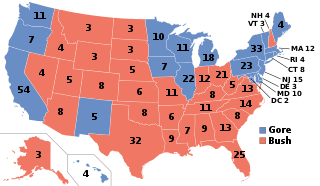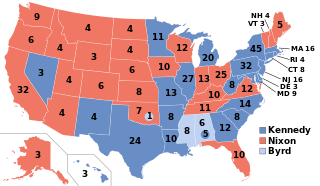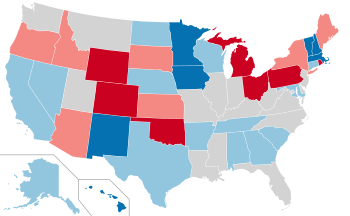
The 1968 United States House of Representatives elections were elections for the United States House of Representatives on November 5, 1968, to elect members to serve in the 91st United States Congress. They coincided with Richard M. Nixon's election as president. Nixon's narrow victory yielded only limited gains for his Republican Party, which picked up a net of five seats from the Democratic Party. The Democrats retained a majority in the House.

The 1962 United States House of Representatives elections was an election for the United States House of Representatives on November 6, 1962, to elect members to serve in the 88th United States Congress. They occurred in the middle of President John F. Kennedy's term. As in most midterm elections, Kennedy's Democratic Party lost seats to the opposition Republican Party, but retained a majority. House Democrats were expected to lose their majority, but the resolution over the Cuban Missile Crisis just a few weeks prior led to a rebound in approval for the Democrats under President Kennedy.

The 2008 United States elections were held on Tuesday, November 4, 2008, during the war on terror and the onset of the Great Recession. It was a considered a Democratic wave election, with Democratic Senator Barack Obama of Illinois defeating Senator John McCain of Arizona by a wide margin, and the Democrats bolstering their majorities in both chambers of Congress.

The 2010 United States elections were held on Tuesday, November 2, 2010, in the middle of Democratic President Barack Obama's first term. Republicans ended unified Democratic control of Congress and the presidency by winning a majority in the House of Representatives and gained seats in the Senate despite Democrats holding Senate control.

The 1974 United States elections were held on November 5. The elections occurred in the wake of the Watergate scandal and three months into the term of Republican President Gerald Ford. Democrats expanded their majorities in both houses of Congress.

The 1980 United States elections were held on Tuesday, November 4. Republican presidential nominee Ronald Reagan defeated incumbent Democratic President Jimmy Carter in a landslide. Republicans picked up seats in both chambers of Congress and won control of the Senate, though Democrats retained a majority in the House of Representatives. The election is sometimes referred to as part of the "Reagan Revolution", a conservative realignment in U.S. politics and marked the start of the Reagan Era.

The 2002 United States elections were held on November 5, in the middle of Republican President George W. Bush's first term. Republicans won unified control of Congress, picking up seats in both chambers of Congress, making Bush the first President since Franklin D. Roosevelt in 1934 to gain seats in both houses of Congress. In the gubernatorial elections, Democrats won a net gain of one seat. The elections were held just a little under fourteen months after the September 11 attacks. Thus, the elections were heavily overshadowed by the War on Terror, the impending Iraq War, the early 2000s recession, and the sudden death of Democratic Senator Paul Wellstone of Minnesota about one week before the election.

The 2000 United States elections were held on November 7, 2000. Republican Governor George W. Bush of Texas defeated Democratic Vice President Al Gore of Tennessee in the presidential election. Republicans retained control of both houses of Congress, giving the party unified control of Congress and the presidency for the first time since the 1954 elections.

The 1986 United States elections were held on November 4 and elected the members of the 100th United States Congress. The elections occurred in the middle of Republican President Ronald Reagan's second term. Democrats regained unified control of both chambers of Congress for the first time since the 1980 elections.

The 1984 United States elections was held on November 6, and elected the members of the 99th United States Congress. Republicans won a landslide victory in the presidential election, picked up seats in the House of Representatives, and successfully defended their Senate majority.

The 1988 United States elections were held on November 8 and elected the President of the United States and members of the 101st United States Congress. Republican Vice President George H. W. Bush defeated Democratic Governor of Massachusetts Michael Dukakis. Despite Dukakis' defeat, the Democratic Party built on their majorities in Congress.

The 1972 United States elections was held on November 7, and elected the members of the 93rd United States Congress. The election took place during the later stages of the Vietnam War. The Republican Party won a landslide victory in the presidential election, and picked up seats in the House, but the Democratic Party easily retained control of Congress. This was the first election after the ratification of the 26th Amendment granted the right to vote to those aged 18–20.

The 1968 United States elections were held on November 5, and elected members of the 91st United States Congress. The election took place during the Vietnam War, in the same year as the Tet Offensive, the assassination of Martin Luther King, Jr., the assassination of Robert F. Kennedy, and the protests of 1968. The Republican Party won control of the presidency, and picked up seats in the House and Senate, although the Democratic Party retained control of Congress.

The 1970 United States elections were held on November 3, and elected the members of the 92nd United States Congress. The election took place during the Vietnam War, in the middle of Republican President Richard Nixon's first term. The Democratic Party defended their control of Congress by retaining its Senate majority and increasing its majority in the House of Representatives.

The 1960 United States elections was held on November 8, and elected the members of the 87th United States Congress. Democratic Senator John F. Kennedy narrowly defeated Republican incumbent Vice President Richard Nixon in the presidential election, and although Republicans made gains in both chambers of Congress, the Democratic Party easily maintained control of Congress.

The 1978 United States elections were held on November 7, 1978, to elect the members of the 96th United States Congress. The election occurred in the middle of Democratic President Jimmy Carter's term. Democrats retained control of both houses of Congress.

The 1946 United States elections were held on November 5, 1946, and elected the members of the 80th United States Congress. In the first election after World War II, incumbent President Harry S. Truman and the Democratic Party suffered large losses. After having been in the minority of both chambers of Congress since 1932, Republicans took control of both the House and the Senate.

The 1934 United States elections were held on November 6, 1934. The election took place in the middle of Democratic President Franklin D. Roosevelt's first term, during the Great Depression. The Democrats built on the Congressional majorities they had won in the previous two elections. In the House of Representatives, Roosevelt's party gained nine seats, mostly from the Republican Party. The Democrats also gained nine seats in the U.S. Senate, thereby winning a supermajority. A Progressive also unseated a Republican in the Senate. This marked the first time that an incumbent president's party did not lose seats in both houses in a midterm election, followed by 1998 and 2002. The feat of the president’s party seeing net gains in both the United States Senate and the governorships would not be observed again until 2022. This was the last midterm until 2022 in which the president's party did not lose any state legislative chambers or incumbent senators.

The 1928 United States elections was held on November 6. In the last election before the start of the Great Depression, the Republican Party retained control of the presidency and bolstered their majority in both chambers of Congress.

The 1926 United States elections were held on November 2, 1926, in the middle of President Calvin Coolidge's second term. The Republican Party lost nine seats to the Democratic Party in the House of Representatives but retained a majority. The Republicans also lost six seats to the Democrats in the U.S. Senate but retained their majority. The Democratic gains in Congress were very modest for a midterm election, and since that time, the Republicans had not performed this well in midterm elections under a Republican president until 2002.






















